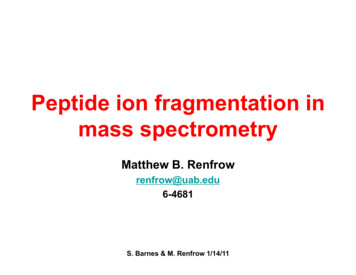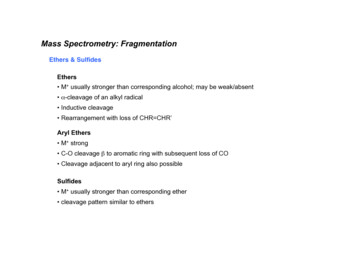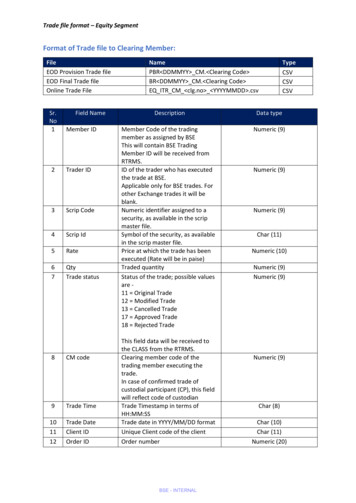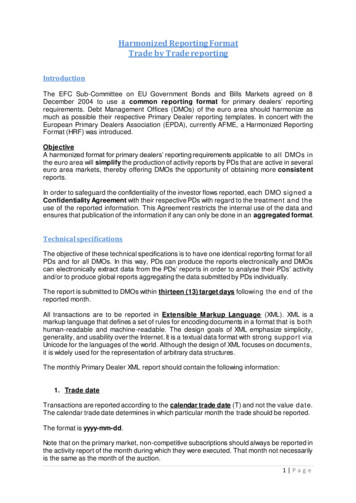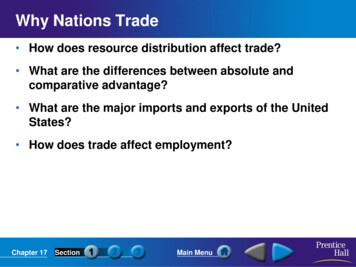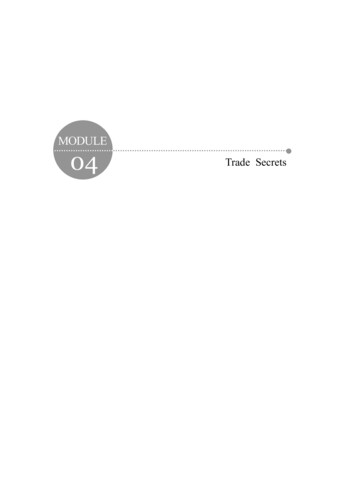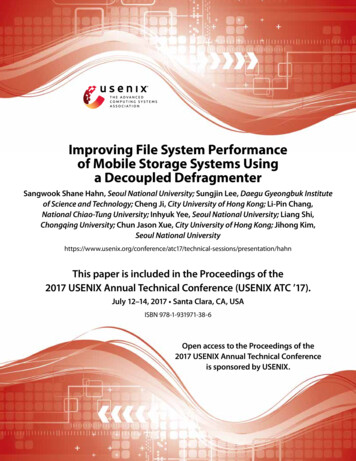
Transcription
NBER WORKING PAPER SERIESFRAGMENTATION AND TRADE IN VALUE ADDED OVER FOUR DECADESRobert C. JohnsonGuillermo NogueraWorking Paper 18186http://www.nber.org/papers/w18186NATIONAL BUREAU OF ECONOMIC RESEARCH1050 Massachusetts AvenueCambridge, MA 02138June 2012We thank Rudolfs Bems, Emily Blanchard, Donald Davis, Andreas Moxnes, Nina Pavcnik, JonathanVogel, David Weinstein, and Kei-Mu Yi for helpful conversations, as well as seminar participantsat Columbia, the IMF, MIT, the NBER Spring ITI Meetings, University of Colorado, and Universityof Houston. Johnson thanks the Rockefeller-Haney fund at Dartmouth College for financial support,and Joseph Celli, Michael Lenkeit, and Sean Zhang for research assistance. The views expressed hereinare those of the authors and do not necessarily reflect the views of the National Bureau of EconomicResearch.NBER working papers are circulated for discussion and comment purposes. They have not been peerreviewed or been subject to the review by the NBER Board of Directors that accompanies officialNBER publications. 2012 by Robert C. Johnson and Guillermo Noguera. All rights reserved. Short sections of text, notto exceed two paragraphs, may be quoted without explicit permission provided that full credit, including notice, is given to the source.
Fragmentation and Trade in Value Added over Four DecadesRobert C. Johnson and Guillermo NogueraNBER Working Paper No. 18186June 2012JEL No. F1ABSTRACTWe combine data on trade, production, and input use to compute the value added content of trade forforty-two countries from 1970 to 2009. For the world, the ratio of value added to gross trade fallsby ten to fifteen percentage points, with two-thirds of this decline in the last two decades. Acrosscountries, declines range from zero to twenty-five percentage points, with large declines concentratedamong countries undergoing structural transformation. Across bilateral trade partners, declines arelarger for nearby partners and partners that adopt regional trade agreements. That is, both policy andnon-policy trade costs shape production fragmentation.Robert C. JohnsonDepartment of EconomicsDartmouth College6106 Rockefeller HallHanover, NH 03755and NBERrobert.c.johnson@dartmouth.eduGuillermo NogueraColumbia Business School325-F Uris Hall3022 BroadwayNew York, NY 10027gn2195@columbia.edu
Recent decades have seen the emergence of global supply chains in which productionstages are sliced up and distributed across countries. Despite their prominence, we lack acomprehensive understanding of the causes and consequences of this production fragmentation. One reason is that measuring changes in supply chains across countries and overtime in a systematic way has proven difficult. A fundamental challenge is that the nationalaccounts record data on gross shipments of goods across borders, not the locations at whichvalue is added at different stages of the production process. Yet for many questions, rangingfrom how global supply chains influence income distribution to how they transmit shocksacross borders, what we care about is how fragments of value added are combined via theglobal supply chain to form final goods.1 That is, we would like to pierce the veil of thegross flows and measure trade in value added directly.This paper computes and analyzes the value added content of trade over the last fourdecades (1970-2009). In doing so, we make three main contributions. First, we combinetime series data on trade, production, and input use to construct an annual sequence ofglobal input-output tables covering forty-two countries back to 1970. For each year, we linknational input-output tables together using bilateral trade data to form a synthetic globalinput-output table that tracks shipments of final and intermediate goods between countries.We then use this global table to compute ‘value added exports.’ Analogous to gross exports,value added exports measure the amount of value added from a given source country that isconsumed in each destination (i.e., embodied in final goods absorbed in that destination).In the aggregate, the ratio of value added to gross exports measures the extent of doublecounting in trade statistics, an important metric of production fragmentation in the contextof models of sequential, multi-stage production.2 At the bilateral level, the ratio of valueadded to gross trade is a marker for both bilateral production chains, as well as multi-countryproduction chains in which value added transits through third countries en route from sourceto destination. Therefore, changes in the ratio of value added to gross trade through time area metric for changes in the structure of cross-border supply chains. Measuring these changesis a prerequisite both for empirical work aimed at identifying the fundamental drivers offragmentation and for calibrating models that measure the consequences of rising fragmentation.1As Grossman and Rossi-Hansberg (2007, p.66-67) put it: “The measurement of trade as gross values ofimports and exports was perhaps appropriate at a time when trade flows comprised mostly finished goods.But such measures are inadequate to the task of measuring the extent of a country’s international integrationin a world with global supply chains.we would like to know the sources of the value added embodied in thegoods and the uses to which the goods are eventually put.”2For example, see Dixit and Grossman (1982), Yi (2003, 2010), Baldwin and Venables (2010), or Costinot,Vogel, and Wang (forthcoming). Standard ‘gravity-style’ trade models also often include an input-outputloop that can be interpreted as a multi-stage production process.2
Our second contribution is to document new stylized facts regarding the evolution offragmentation for the world as a whole, individual countries, and among bilateral tradepartners. For the world as a whole, the ratio of value added to gross exports – henceforththe ‘VAX ratio’ for short – is declining over time, falling by ten to fifteen percentage pointsover four decades. Interestingly, this decline is not uniform through time: the world VAXratio falls during the 1970’s, is stable through the 1980’s, and then falls dramatically duringthe 1990’s. The decline in the VAX ratio after 1990 is roughly three times as fast as thedecline prior to 1990.Beneath these global results, both the magnitude and timing of declines in VAX ratiosdiffer across countries and bilateral trading partners. Across countries, the median declineis roughly 0.13 (for the Netherlands or France), with an interdecile range of 0.24 (forIreland) to 0.04 (for the United Kingdom or Japan). We show that declines tend to belargest for fast growing countries undergoing structural transformation, but some advancedcountries (e.g., Germany) also experience large declines. Across bilateral partners, there isalso ample variation. For example, the VAX ratio falls by 0.29 for U.S. exports to Mexico,but is nearly unchanged for U.S. exports to Japan. This bilateral variation reflects bothchanges in the extent to which exports to a given destination are used in production ofexports (i.e., the extent of vertical specialization in the destination), as well as changes inhow a given source country serves the destination via third markets.Our third contribution is to show that trade barriers are significant determinants ofchanges in fragmentation patterns. Among non-policy trade barriers, distance is particularlyimportant. In the cross-section, bilateral VAX ratios are higher for distant trading partners,meaning that on average value added exports ‘travel further’ than gross exports. In thetime series, distance is a strong predictor of changes in the VAX ratio, with the largestdeclines in VAX ratios concentrated among proximate trading partners.3 While both grossand value added trade become more sensitive to distance over time, the change for grosstrade is significantly larger than trade in value added. This suggests that fragmentationmay be important in explaining the increasing influence of distance on trade, highlighted byDisdier and Head (2008).Turning to policy trade barriers, we show that regional trade agreements have largeeffects on bilateral VAX ratios. In levels, these agreements raise both gross and value addedtrade, but gross trade rises substantially more. For a typical agreement, gross trade rises byaround 30% and value added trade rises by 23%, so the VAX ratio falls by 7%. Further, deeptrade agreements (e.g., common markets and economic unions) are associated with largerdeclines in VAX ratios than shallow agreements (e.g., preferential agreements or free trade3See Johnson and Noguera (2012b) for additional results on distance and fragmentation.3
agreements). These results demonstrate that trade policy changes influence fragmentation.They are also interesting in light of the fact that many agreements were explicitly adopted topromote integration of production chains across borders, yet systematic evidence that theyhave succeeded in this goal is scarce.Our study contributes to an active recent literature on global input-output linkages.4 Todate, this literature mostly focuses on measuring trade in value added over short time spans,often a single recent year. In contrast, we focus here on changes over long periods of time.In that focus, our work is closely related to Hummels, Ishii, and Yi (2001), who constructedmeasures of the import content of exports for ten countries from 1970 to 1990. Our workextends both country and time coverage relative to Hummels et al. Most importantly, theglobal input-output framework we use allows us to measure changes in value added trade atthe bilateral level, a dimension of the data that has been under-explored.5The paper proceeds as follows. Section 1 articulates the input-output framework we useto construct measures of trade in value added, and Section 2 discusses interpretation of valueadded trade flows. Section 3 then describes how we construct the empirical counterpart tothis framework from available data, with details on data and methods in the appendix.Section 4 provides a general overview of variation in VAX ratios through time for the world,individual countries, and bilateral trade partners. We then explore the role of trade costs inshaping bilateral flows in detail in Section 5. Section 6 concludes.1Tracking Value Added in Global Supply ChainsWe begin by laying out the global input-output framework, drawing on the exposition inJohnson and Noguera (2012a). We then demonstrate how to compute the value addedcontent of trade. The basic procedure has two main steps. First, using the global inputrequirements matrix, we compute the total output from each country and sector needed toproduce the vector of final goods absorbed in a given destination. Second, we use sourcecountry value added to export ratios to compute the domestic value added embodied in thatoutput.4Among others, see Bems, Johnson, and Yi (2010), Trefler and Zhu (2010), Daudin, Rifflart, andSchweisguth (2011), Erumban, Los, Stehrer, Timmer, and de Vries (2011), Johnson and Noguera (2012a,2012b), and Koopman, Powers, Wang, and Wei (2011). This literature itself builds on a long tradition ofmulti-region input-output models, dating to Moses (1955).5Other related work aimed at measuring changes in input-output linkages over time includes the IDEJETRO Asian Input-Output Tables (which we draw on for data) and the new World Input-Output Database(WIOD). Working contemporaneously, WIOD researchers assembled detailed data for the 1995-2007 period(see Timmer (2012)). See also Wang (2011) for work on the post-1995 period. These post-1995 tables missmany important changes in value added versus gross trade over time. As will be evident below, most of ourresults depend on measuring linkages over longer periods of time.4
1.1A Global Input-Output FrameworkTo start, let there be S sectors and N countries in a given year t. Output in each sector of eachcountry is produced using domestic factors (capital, labor, etc.) and intermediate inputs,which may be sourced from home or foreign suppliers. Output is tradable in all sectors,and may used to satisfy final demand or used as an intermediate input in production athome or abroad. Final demand itself consists of consumption, investment, and governmentexpenditure.To track shipments of final and intermediate goods, we define a four-dimensional notation denoting source and destination country, as well as source and destination sectors forshipments of intermediates. We define i to be the source country, j to be the destinationcountry, s to be the source sector, and s0 to be the destination sector.For a given year, the global input-output framework organizes these flows using marketclearing conditions. Because we observe the value of cross-border transactions in the data,not quantities shipped, we write these market clearing conditions in value terms. Sincemarkets implicitly clear in quantities, this means we are evaluating the underlying quantityflows at a common set of prices to ensure that revenue for producers equals the value ofexpenditure across destinations. We write the market clearing condition as:yit (s) Xfijt (s) jXXjmijt (s, s0 ),(1)s0where yit (s) is the value of output in sector s of country i, fijt (s) is the value of final goodsshipped from sector s in country i to country j, and mijt (s, s0 ) is the value of intermediatesfrom sector s in country i shipped to sector s0 in country j. Gross bilateral exports, denotedxijt (s), include goods destined for both final and intermediate use abroad: xijt (s) fijt (s) P0s0 mijt (s, s ). Then Equation (1) equivalently says that output is divided between domesticfinal use, domestic intermediate use, and gross exports.These market clearing conditions can be stacked to form a compact global input-outputsystem. First, we collect the total value of production in each sector in the S 1 vectoryit . Second, we organize shipments of final goods from i to country j into S 1 vectors fijt .Third, we denote use of intermediate inputs from i by country j by Aijt yjt , where Aijt is anS S input-output matrix with elements Aijt (s, s0 ) mijt (s, s0 )/yjt (s0 ). A typical elementdescribes the value of output from sector s in source country i used in the production ofsector s0 output by destination country j. The vector of gross exports from i to j (i 6 j) isthen xijt fijt Aijt yjt .5
Then we can rewrite the S N market clearing conditions from Equation (1) as:y t A t y t ft , A11t A21twith At . .A12tA22t.···. A1N t A2N t . ,. (2) y1t y2t yt . , . AN 1t AN 2t . . . AN N tyN t P f1jtj P j f2jt .and ft . . Pj fN jt(3)We refer to At as the global input-output matrix. It concisely summarizes the entire structureof within-country, cross-country, and cross-sector intermediate goods linkages at a given pointin time.Rearranging Equation (2), we can write the output vector as:yt (I At ) 1 ft .(4)The matrix (I At ) 1 is the “Leontief inverse” of the global input-output matrix. TheLeontief inverse tells us how much output from each country and sector is required to producea given vector of final goods, where here the vector of final goods is total world absorption offinal goods ft . The gross output required to produce ft includes the final goods themselvesplus all the intermediate goods used up in successive rounds of the production process.1.2The Value Added Content of TradeTo compute the value added content of trade, we split ft into destination specific vectors f jt ,where f jt is the (SN 1) vector of final goods absorbed in country j. Then Equation (4)can be re-written as: f1jt X f2jt 1 yt (I At ) fjt with fjt (5) . . . jfN jtInside the summation, (I At ) 1 f jt is the vector of output used directly and indirectly toproduce final goods absorbed in country j.Then, Equation (5) decomposes output from each source country i into the amountof output from the source used to produce final goods absorbed in each destination. To6
formalize this, we define: y1jt y2jt . (I At ) 1 f jt , . . (6)yN jtwhere yijt is the S 1 vector of output from i used to produce final goods absorbed in j.Given that we know how much output from each source is needed to produce final goodsin each destination, then we can naturally compute the value added from the source countryembedded in this output. If the ratio of value added to gross output in sector s of sourceP Pcountry i is rit (s) 1 j s0 Ajit (s0 , s), then the amount of value added from sector s incountry i embodied in final goods absorbed in j is: vaijt (s) rit (s)yijt (s), where yijt (s) isan individual element of yijt defined above. We refer to vaijt (s) as value added exports.2Interpreting Value Added TradeTo guide interpretation of the empirical results below, we pause here to discuss the mechanicsof the value added calculation.6 First, we highlight how the value added to export ratio canbe linked to alternative models with fragmented production. Second, we interpret differencesbetween value added and gross exports using a first-order approximation to the full valueadded calculation. Third, we discuss how value added trade is related to measures of tradein intermediate goods.2.1Models with Fragmented ProductionThe basic accounting system outlined in Equations (1) and (2) above could be consistentwith various underlying models of production, as it simply tracks shipments of intermediatesand final goods by industrial sector. Moving from Equations (2) to (4) entails making theassumption that the production process is circular, composed of an effectively infinite numberof stages, where input requirements and the uses of output at each stage are identical.These are strong restrictions, yet they are embedded into many standard trade models.For example, many gravity-style models satisfy these restrictions. These models typicallyassume that gross output is produced using a CES composite intermediate input, whichaggregates tradable intermediates from different sectors and country sources, and is allocatedinterchangeably to final and intermediate uses.7 Therefore, the procedure for computing the67See also Johnson and Noguera (2012a) for interpretative discussion.See Caliendo and Parro (2010), Eaton, Kortum, Neiman, and Romalis (2011), and Levchenko and Zhang7
value added content of trade naturally emerges from these models.Models of sequential multi-stage production also generate flows of final and intermediatethat are consistent with Equations (1) and (2).8 In this type of model, there is a sequence ofproduction stages that must be performed in order, with intermediate output being passedfrom one stage to the next. When stages are split across countries, this feature generatesgross trade that is a multiple of trade in value added. This discrepancy between gross andvalue added trade flows is a key metric that summarizes how much fragmentation has takenplace.It is worth noting, however, that multi-stage models do not necessarily feature circularityin the production process, and therefore need not imply the inversion operation in Equation(4). For example, in the two-stage model of Yi (2003), stage one goods are used to producestage two goods, which are then fed into final demand channels. As such, there is nointermediate goods loop in which stage two goods are used as intermediates in stage one.Nonetheless, that model does produce double-counting in trade statistics, even if it does notimply the exact accounting procedure in this paper.9 We now turn to explaining the linkbetween two-step and many-step production processes in detail, as the two-step process isuseful for building intuition.2.2Approximate AccountingTo aid interpretation, we outline an approximate two-step formulation of the general accounting procedure. This approximation enables us write down simple analytical expressions forvalue added and gross trade that capture the first-order influence of cross-border input linkages. These expressions echo the two-step computations in Hummels, Ishii, and Yi (2001)and Yi (2003), though extended here for the multilateral context. This approximation alsocaptures roughly half of the bilateral variation in the true data, so it will prove useful tostudy the mechanics underlying deviations of value added from gross trade.10To understand the approximation, note that the Leontief Inverse can be expressed as aPkgeometric series: (I A) 1 k 0 A . If we multiply the k-th order term by the finaldemand vector – i.e. compute Ak f jt – then we get the value of intermediates used in the(2011) for Ricardian models with these features. Armington type gravity models with production functionsfor gross output also typically satisfy these restrictions.8See Yi (2003, 2010), Dixit and Grossman (1982), Baldwin and Venables (2010), or Costinot, Vogel, andWang (2011).9Yi (2010) does include an intermediate goods loop, in which the second stage goods are used to form aCES composite input used in the first stage. Mapping this model to our data is topic for future work.10Though the algebra is more cumbersome, we can obviously perform higher order approximations as well.By definition, these fit the data better and capture an additional layer of nuance. They do not add newfundamental insights, however.8
k-th step of the production process. The two-step approximation restricts attention to thezero and first order terms of this expansion: the final goods themselves and intermediatesdirectly used to produce them. That is, we compute the first-order approximate amountPof output needed to produce final goods, defined as: ȳt j [I At ]f jt . The output fromPcountry i used to produce f jt is then: ȳij fij k Aik fkj .Using these output transfers, along with the underlying shipments of final and intermediate goods, we construct approximate gross and value added exports as:xij fij Aij fjj Aij fji {z} {z }absorptionreflectionX {zredirection0}vaij fij Aii fij Aij fjj [ι [Aii AIi ] diag(fij )] {z}net absorption(7)Aik fkjk6 i,jXAik fkj ,(8)k6 i,j {z}indirect exportsPwhere AIi k6 i Aki is the overall imported input use matrix for country i.We group the components of approximate exports into three terms.11 First, fij Aij fjjis shipments from i to j that are absorbed in j, including both final goods (fij ) and intermediates from i embodied in country j’s consumption of its own final goods (Aij fjj ). Second,Aij fji is shipments of intermediates from i to j that are ‘reflected’ back to country i, embodPied in final goods produced by j. Third, k6 i,j Aik fkj is shipments of intermediates from ito j that are ‘redirected’ onward to third markets, embodied in final goods produced by j.We group the components of approximate value added exports into two terms. Aggregated across sectors, the first term is equal to ‘absorption’ (defined above) minus the imported0intermediate goods used to produce exported final goods fij , given by [ιAIi diag(fij )] . Wetherefore refer to this term as ‘net absorption’.12 The second term records ‘indirect exports’:the amount of value added from country i absorbed in country j that travels through thirdcountries. In the two-step calculation, this is equal to shipments of intermediates from i tothird destinations k that are embodied in final goods produced by k and absorbed in j.At the bilateral level, we can then define the approximate ratio of value added to gross11In Johnson and Noguera (2012a), we defined these terms somewhat differently. Rather than decomposingapproximate exports, we chose to decompose actual exports in that paper. The intuition for how we brokedown actual gross exports is closely related to the intuition presented here.12At the sector level, net absorption is equal to absorption plus the domestic intermediates used to produce0final goods exports (Aii fij ) minus total intermediate use ([ι [Aii AIi ] diag(fij )] ). Aggregating acrosssectors, domestic intermediates cancel out. Further, recall that we have a two-step production process here,so no intermediates are used to produce intermediates. Therefore, intermediates themselves are 100% valueadded under this approximation.9
exports as:V AX ij net absorptionij indirect exportsijιvaij .ιxijabsorptionij reflectionij redirectionij(9)Note three ways in which production fragmentation influences the approximate VAX ratio.First, if ‘indirect exports’ are zero, then V AX ij is less then one. Absorption less importedinputs is guaranteed to be less than absorption itself, and gross exports are composed ofabsorption plus reflected/redirected exports. Further, note that for a given source country i,the ratio of net absorption to total absorption varies across destinations only to the extentthat final goods sectors vary in imported input intensity and the composition of final goodsexports varies across destinations.13 In practice, this limits variation in V AX ij , becauseexport composition tends to be similar across destinations for a given exporter.Second, if ‘indirect exports’ are greater than zero, these push up V AX ij . In fact, ifindirect exports are large enough, then V AX ij may exceed one. These indirect exportsare a natural outcome of fragmented production, as they reflect redirection trade in thirddestinations (k 6 i, j)).Third, V AX ij is decreasing in the extent of ‘re-direction and reflection’ in bilateral trade.This component of gross exports reflects double-counting, as it includes shipments to j thatare not absorbed there, but show up in j’s own exports.For convenience, we refer to these three margins of adjustment in approximate VAX ratios as the absorption, indirect exports, and reflection/redirection margins. All three reflectdifferent dimensions of cross-border fragmentation, so we use this breakdown to illustrate themechanics of changes in VAX in later sections. As we move from approximate to actual bilateral VAX ratios that include higher order terms, we lose this exact decomposition. However,the basic intuition of the approximate decomposition survives. The core of this intuition isthat bilateral value added to export ratios are shaped by both bilateral production chains,which involve back-and-forth shipments of intermediates and final goods between bilateralpartners, as well as multilateral production chains that involve three or more countries.Moving from bilateral to multilateral trade, the multilateral VAX ratio is straightforwardto interpret. Starting with the approximation, note that the indirect exports and redirectionterms are two sides of the same coin. As we aggregate across destinations, these then appearin both the numerator and denominator. So in the aggregate, they do not affect the valueadded to export ratio. The only remaining components are: (a) the use of imported inputsto produce exports, driving a wedge between absorption and net absorption, and (b) the13This is an outcome of the assumption that gross output is homogeneous within sectors, so input requirements do not depend on how the good is used or where it is shipped.10
reflection of exports back to the source, embodied in final goods imports. Increases in eitherof these drive the aggregate VAX ratio down.14 This intuition survives intact when movingfrom the approximate to full calculation.2.3Trade in IntermediatesIn contrast to our focus on value added versus gross trade, many other researchers haveused measures of intermediate goods trade or trade in parts and components as a measurefragmentation.15 These measures capture different information than the information embedded in value added to export ratios. We therefore pause to contrast our approach to thisalternative.While countries must trade intermediates in order to have gross trade in excess of valueadded trade, trade in intermediates does not guarantee this result. Specifically, what mattersis how intermediates are used in particular destinations. If shipments of intermediates areused to produce goods absorbed in the destination, then these intermediate goods shipmentsrepresent trade in value added. This is captured in the Aij fjj term in approximate valueadded exports above. In contrast, if the intermediates are reflected or redirected to beabsorbed either in the source or third countries, then there is a wedge between gross andvalue added trade.The fact that intermediate goods trade and value added to export ratios capture differentinformation helps us reconcile the observation that the share of intermediate goods in tradehas not apparently risen over time, documented for example by Chen, Kondratowicz, andYi (2005), with our observation that the global ratio of value added to gross trade is falling.It also guides us in interpreting our results on RTAs. Whereas we detect differential effectsof RTAs on gross and value added trade, Orefice and Rocha (2011) find that trade in partsand components increases by the same amount as ‘final’ trade (i.e., total trade less partsand components) following adoption of bilateral trade agreements.16 These examples makethe point that care is needed in reading our results in the context of this related literature.14Further, the ratio of value added to gross exports is bounded by one.Among others, see Yeats (2001), Baldwin and Taglioni (2011), Behar and Freund (2011), and Oreficeand Rocha (2011).16Also related to our results below, they find that final and intermediates goods respond similarly toincreasing depth of trade agreements.1511
3Empirical ProcedureTo measure the value added content of trade, we need to track output yt , the global inputoutput matrix At , final goods shipments fijt , and value added to output ratios rit throughtime. We confront two challenges in doing so. First, sector-level production, input use,and trade data for many countries is incomplete and split across sources.
In levels, these agreements raise both gross and value added trade, but gross trade rises substantially more. For a typical agreement, gross trade rises by around 30% and value added trade rises by 23%, so the VAX ratio falls by 7%. Further, deep trade agreements (e.g., common markets and economic unions) are associated with larger
